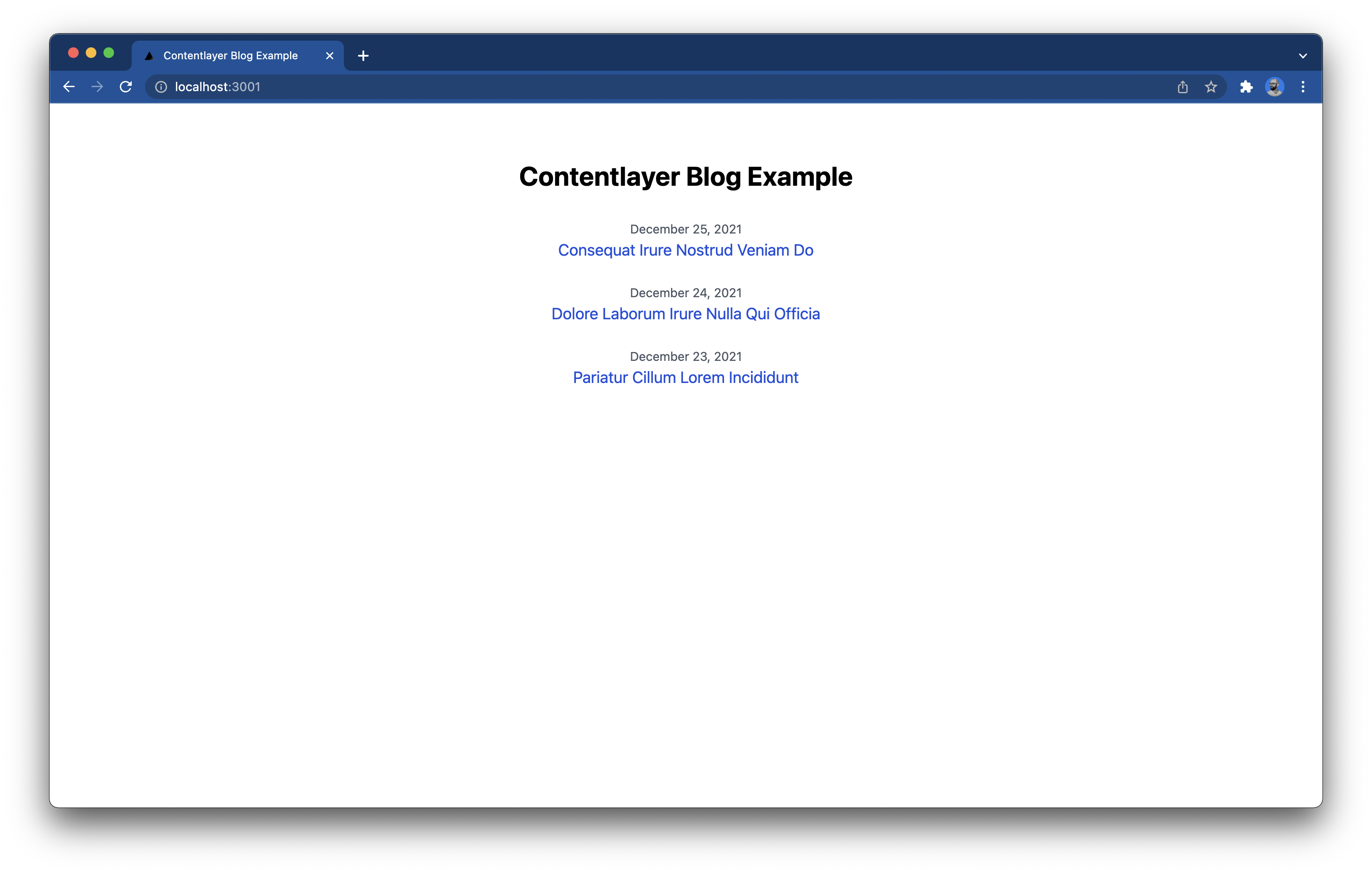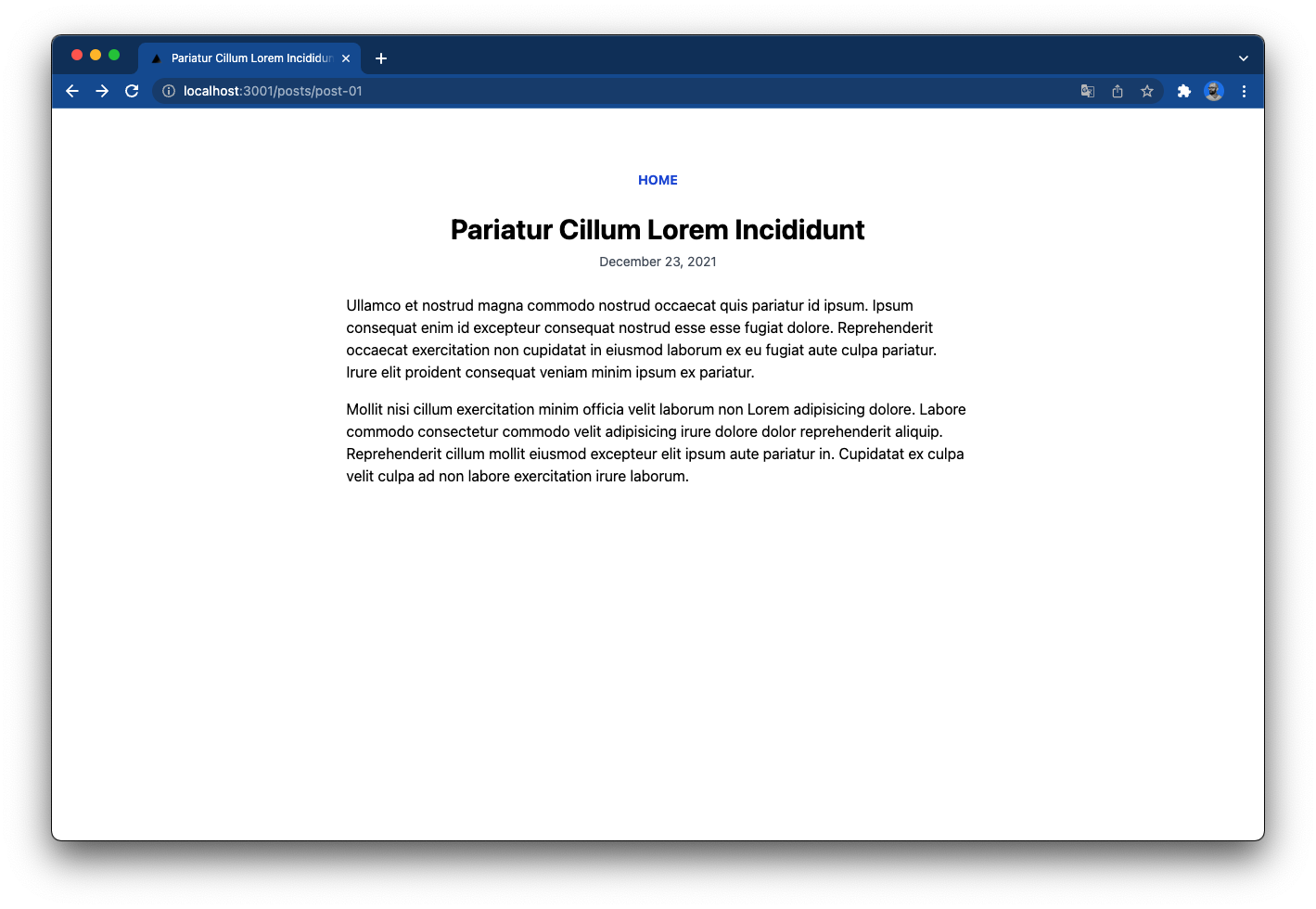Getting Started
This tutorial will get you comfortable with the basics of Contentlayer by walking through how to to build a simple blog site using Next.js.
The blog will include a list of posts with a title, body, and date, rendered with the most recent on top. And each post will have its own page.
Try it Now
If you'd like to dive right in and start playing with Contentlayer, you can open the project in Gitpod.
Example Project
You can find a working version of this tutorial in this state of the example project.
See the examples page for a full list of examples.
1. Setup Project
Just to demonstrate how quickly we can start working, let's start with a new blank Next.js project.
New Next.js App
Create a new Next.js project.
npx create-next-app contentlayer-example
That command will place the project in a contentlayer-example directory. Change into that directory.
cd contentlayer-example
Add Tailwind
If you'd like to see some styling as we go without much extra effort, follow these instructions to add Tailwind to your project.
2. Install Contentlayer
Install Contentlayer and the Next.js plugin.
npm install contentlayer next-contentlayer
To hook Contentlayer into the next dev and next build processes, you'll want to wrap the Next.js configuration using the withContentlayer method.
Create a new file called next.config.mjs in the root of your project, and add the following content.
// next.config.mjs
import { withContentlayer } from 'next-contentlayer'
export default withContentlayer({})
Then add the following lines to your tsconfig.json or jsconfig.json file:
{
"compilerOptions": {
"baseUrl": ".",
"paths": {
"contentlayer/generated": ["./.contentlayer/generated"]
// ^^^^^^^^^^^^^^^^^^^^^^^^^^^^^^^^^^^^^^^^^^^^^^^^^^^
}
},
"include": ["next-env.d.ts", "**/*.tsx", "**/*.ts", ".contentlayer/generated"]
// ^^^^^^^^^^^^^^^^^^^^^^^^^^^
}
Contentlayer generates files in the .contentlayer/generated directory. This tells JavaScript (or TypeScript) to create an alias of contentlayer/generated to the generated files directory.
3. Define Post Schema
Now that we have everything installed, we can begin to define our document schema. A document is an individual piece of content that Contentlayer transforms into data you can use in your components.
Because we're building a simple blog site, let's define a single document type called Post. Create a file contentlayer.config.js in the root of your project, and add the following content.
// contentlayer.config.js
import { defineDocumentType, makeSource } from 'contentlayer/source-files'
export const Post = defineDocumentType(() => ({
name: 'Post',
filePathPattern: `**/*.md`,
fields: {
title: {
type: 'string',
description: 'The title of the post',
required: true,
},
date: {
type: 'date',
description: 'The date of the post',
required: true,
},
},
computedFields: {
url: {
type: 'string',
resolve: (post) => `/posts/${post._raw.flattenedPath}`,
},
},
}))
export default makeSource({
contentDirPath: 'posts',
documentTypes: [Post],
})
This configuration specifies a single document type called Post. These documents are expected to be .md files that live within a posts directory in your project. And data objects generated from these files will have the following properties:
title: String pulled from the file's frontmatter.date: JavaScriptDateobject, pulled from the file's frontmatter.body: An object that contains therawcontent from the markdown file and the convertedhtmlstring. (This is built into Contentlayer by default and does not have to be defined.)url: A string that takes the name of the file (without the extension) and prepends/posts/to it, thus defining that path at which that content will be available on your site. (More on this soon.)
4. Add Post Content
Create a few markdown files in a posts directory and add some content to those files.
Here's an example of what a post file at posts/post-01.md might look like:
---
title: Lorem Ipsum
date: 2021-12-24
---
Ullamco et nostrud magna commodo nostrud occaecat quis pariatur id ipsum. Ipsum
consequat enim id excepteur consequat nostrud esse esse fugiat dolore.
Reprehenderit occaecat exercitation non cupidatat in eiusmod laborum ex eu
fugiat aute culpa pariatur. Irure elit proident consequat veniam minim ipsum ex
pariatur.
Mollit nisi cillum exercitation minim officia velit laborum non Lorem
adipisicing dolore. Labore commodo consectetur commodo velit adipisicing irure
dolore dolor reprehenderit aliquip. Reprehenderit cillum mollit eiusmod
excepteur elit ipsum aute pariatur in. Cupidatat ex culpa velit culpa ad non
labore exercitation irure laborum.
The examples to follow will have three posts in this structure:
posts/
├── post-01.md
├── post-02.md
└── post-03.md
5. Add Post Feed
Now we can tie it all together by bringing the data into our pages.
Date Formatting Helper
Before we get into the pages, add a library to help us with formatting the date.
npm install date-fns
Replace Home Page
Replace the default home page (pages/index.js) with a listing of all the posts and links to the individual post pages.
// pages/index.js
import Head from 'next/head'
import Link from 'next/link'
import { compareDesc, format, parseISO } from 'date-fns'
import { allPosts } from 'contentlayer/generated'
export async function getStaticProps() {
const posts = allPosts.sort((a, b) => {
return compareDesc(new Date(a.date), new Date(b.date))
})
return { props: { posts } }
}
function PostCard(post) {
return (
<div className="mb-6">
<time dateTime={post.date} className="block text-sm text-slate-600">
{format(parseISO(post.date), 'LLLL d, yyyy')}
</time>
<h2 className="text-lg">
<Link href={post.url}>
<a className="text-blue-700 hover:text-blue-900">{post.title}</a>
</Link>
</h2>
</div>
)
}
export default function Home({ posts }) {
return (
<div className="mx-auto max-w-2xl py-16 text-center">
<Head>
<title>Contentlayer Blog Example</title>
</Head>
<h1 className="mb-8 text-3xl font-bold">Contentlayer Blog Example</h1>
{posts.map((post, idx) => (
<PostCard key={idx} {...post} />
))}
</div>
)
}
Notice that the data was already available to us as allPosts, coming from contentlayer/generated. We used allPosts to sort the post in reverse chronological order, and then sent the posts to the home page as props.
The home page then used the post data to map through the individual posts and render PostCard components. As your site grows, you'll want to break these components out into their own files. We're showing everything in the same file here to keep things simple.
Run the App
Now you're ready to take it for a spin. Fire up the Next.js dev server.
npm run dev
And visit localhost:3000 in your browser. You should see a listing of the posts you added to the posts directory!

6. Add Post Layout
Notice that if you click on individual posts, you get a 404 error. That's because we haven't created the pages for these posts. Let's do that!
Create the page at pages/posts/[slug].js and add the following code.
// pages/posts/[slug].js
import Head from 'next/head'
import Link from 'next/link'
import { format, parseISO } from 'date-fns'
import { allPosts } from 'contentlayer/generated'
export async function getStaticPaths() {
const paths = allPosts.map((post) => post.url)
return {
paths,
fallback: false,
}
}
export async function getStaticProps({ params }) {
const post = allPosts.find((post) => post._raw.flattenedPath === params.slug)
return {
props: {
post,
},
}
}
const PostLayout = ({ post }) => {
return (
<>
<Head>
<title>{post.title}</title>
</Head>
<article className="mx-auto max-w-2xl py-16">
<div className="mb-6 text-center">
<Link href="/">
<a className="text-center text-sm font-bold uppercase text-blue-700">Home</a>
</Link>
</div>
<div className="mb-6 text-center">
<h1 className="mb-1 text-3xl font-bold">{post.title}</h1>
<time dateTime={post.date} className="text-sm text-slate-600">
{format(parseISO(post.date), 'LLLL d, yyyy')}
</time>
</div>
<div className="cl-post-body" dangerouslySetInnerHTML={{ __html: post.body.html }} />
</article>
</>
)
}
export default PostLayout
Notice again that we're importing data from contentlayer/generated. This is the beauty of Contentlayer. It has already loaded and shaped our date and keeps the logic in getStaticPaths() and getStaticProps() nice and simple.
Now clicking on a post link from the home page should lead you to a working post page.

Next Steps
You now have a simple blog site with Next.js and Contentlayer! 🎉
This is just the beginning. Now you can dig in and add all the bells and whistles necessary to build a site with great content using Contentlayer. Here are a few suggestions:
- Jump into the conceptual guides to learn more about how Contentlayer works.
- Join our Discord community to ask questions, stay up to date, and share your work.
- Check out the examples for inspiration on what you can do with Contentlayer.
- Explore local file source guides for learning about specific techniques.
Was this article helpful to you?
Provide feedback
Last edited on March 31, 2023.
Edit this page